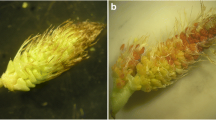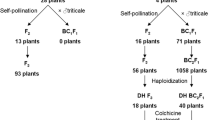Abstract
Wide crossing is one of a number of practical methods that can be used to expand genetic variation in common wheat (Triticum aestivum). However, in crosses between wheat and distantly related species such as maize (Zea mays) and pearl millet (Pennisetum glaucum), non-wheat chromosomes are often eliminated from the hybrid during embryogenesis. In this study, we used pearl millet pollen to pollinate the pistils of a range of plants in the tribe Triticeae, as well as oat. Seven days after pollination, the dynamics of the pearl millet chromosomes in the embryos were observed using in situ hybridization, probing both the pearl millet genomic DNA and its centromere-specific repeats. In embryos from the crosses with oat, all seven of the pearl millet chromosomes were retained. However, in hybrids with the Triticeae species, chromosome elimination occurred during embryogenesis. Pearl millet chromosome showed chromosome rearrangements and non-disjunction together with micronuclei. These rearranged chromosomes and micronuclei derived from the breakage of bridges and retention of acentric fragments in anaphase, respectively. The cause of the chromosome elimination of wheat–pearl millet hybrid is not malfunction of the kinetochores binding to the spindles but the malfunction of the sister chromatids segregation at anaphase especially of chromosome arm.



Similar content being viewed by others
Abbreviations
- 2,4-D:
-
2,4-Dichlorophenoxy acetic acid
- GISH:
-
Genomic in situ hybridization
- FISH:
-
Fluorescence in situ hybridization
- DAPI:
-
4′,6-Diamidino-2-phenylindole
References
Barclay IR (1975) High frequencies of haploid production in wheat (Triticum aestivum) by chromosome elimination. Nature 256:410–411
Bennett MD (1984) Nuclear architecture and its manipulation. In: Gustafson JP (ed) Gene manipulation in plant improvement. Plenum, New York, pp 469–502
Elamein HMM, Ali AM, Garg M, Kikuchi S, Tanaka H, Tsujimoto H (2007) Evolution of chromosomes in genus Pennisetum. Chromosome Sci 10:55–63
Gernand D, Rutten T, Varshney A, Rubtsova M, Prodanovic S, Brub C, Kumlehn J, Houben A (2005) Uniparental chromosome elimination at mitosis and interphase in wheat and pearl millet crosses involves micronucleus formation, progressive heterochromatinization, and DNA fragmentation. Plant Cell 17:2431–2438
Gernand D, Rutten T, Pickering R, Houben A (2006) Elimination of chromosomes in Hordeum vulgare × H. bulbosum crosses at mitosis and interphase involves micronucleus formation and progressive heterochromatinization. Cytogenet Genome Res 114:169–174
Inagaki MN, Mujeeb-Kazi A (1995) Comparison of polyhaploid production frequencies in crosses of hexaploid wheat with maize, pearl millet and sorghum. Breeding Sci 45:157–161
Kamm A, Schmidt T, Heslop-Harrison JS (1994) Molecular and physical organization of highly repetitive, undermethylated DNA from Pennisetum glaucum. Mol Gen Genet 244:420–425
Kasha KJ, Kao KN (1970) High frequency haploid production in barley (Hordeum vulgare L.). Nature 225:874–876
Komeda N, Chaudhary HK, Suzuki G, Mukai Y (2007) Cytological evidence for chromosome elimination in wheat × Imperata cylindrica hybrids. Genes Genet Syst 82:241–248
Laurie DA (1989) The frequency of fertilization in wheat × pearl millet crosses. Genome 32:1063–1067
Laurie DA, Bennett MD (1986) Wheat × maize hybridization. Can J Genet Cytol 28:313–316
Laurie DA, Bennett MD (1988) Cytological evidence for fertilization in hexaploid wheat × sorghum crosses. Plant Breed 100:73–82
Laurie DA, Bennett MD (1989) The timing of chromosome elimination in hexaploid wheat × maize crosses. Genome 32:953–961
Leitch AR, Schwarzacher T, Mosgöller W, Bennett MD, Heslop-Harrison JS (1991) Parental genomes are separated throughout cell cycle in a plant hybrid. Chromosoma 101:206–213
Liu Z, Makaroff CA (2006) Arabidopsis separase AESP is essential for embryo development and the release of cohesin during meiosis. Plant Cell 18:1213–1225
Mochida K, Tsujimoto H (2001) Production of wheat double haploids by pollination with Job’s Tears (Coix lacryma-jobi L.). Heredity 92:81–83
Mochida K, Tsujimoto H, Sasakuma T (2004) Confocal analysis of chromosome behavior in wheat × maize zygotes. Genome 47:199–205
Okagaki RJ, Kynast RG, Livingston SM, Russell CD, Rines HW, Phillips RL (2001) Mapping maize sequences to chromosomes using oat–maize chromosome addition materials. Plant Physiol 125:1228–1235
Riera-Lizarazu O, Rines HW, Phillips RL (1996) Cytological and molecular characterization of oat × maize partial hybrids. Theor Appl Genet 93:123–135
Sanei M, Pickering R, Fuchs J, Banaei Moghaddam AM, Dziurlikowska A, Houben A (2010) Interspecific hybrids of Hordeum marinum ssp. marinum × H. bulbosum are mitotically stable and reveal no gross alterations in chromatin properties. Cytogenet Genome Res 129:110–116
Schwarzacher-Robinson T, Finch RA, Smith JB, Bennett MD (1987) Genotypic control of centromere positions of parental genomes in Hordeum × Secale hybrid metaphases. J Cell Sci 87:291–304
Schwarzacher T, Leitch AR, Bennett MD, Heslop-Harrison JS (1989) In situ localization of parental genomes in a wide hybrid. Ann Bot 64:315–324
Skibbens RV (2000) Holding your own: establishing sister chromatid cohesion. Genome Res 10:1664–1671
Uhlmann F (2001) Secured cutting: controlling separase at the metaphase to anaphase transition. EMBO Rep 2:487–492
Uhlmann F (2003) Chromosome cohesion and separation: from men and molecules. Curr Biol 13:R104–R114
Waizenegger IC, Hauf S, Meinke A, Peters JM (2000) Two distinct pathways remove mammalian cohesin from chromosome arms in prophase and from centromeres in anaphase. Cell 103:339–410
Zenkteler M, Straub J (1979) Cytoembryogical studies on the process of fertilization and the development of haploid embryos of Triticum aestivum L. (2n = 42) after crossing with Hordeum bulbosum (2n = 14). Z Pflanzenzüchtg 82:36–44
Author information
Authors and Affiliations
Corresponding author
Additional information
Responsible Editor: Pat Heslop-Harrison
Rights and permissions
About this article
Cite this article
Ishii, T., Ueda, T., Tanaka, H. et al. Chromosome elimination by wide hybridization between Triticeae or oat plant and pearl millet: pearl millet chromosome dynamics in hybrid embryo cells. Chromosome Res 18, 821–831 (2010). https://doi.org/10.1007/s10577-010-9158-3
Received:
Revised:
Accepted:
Published:
Issue Date:
DOI: https://doi.org/10.1007/s10577-010-9158-3




